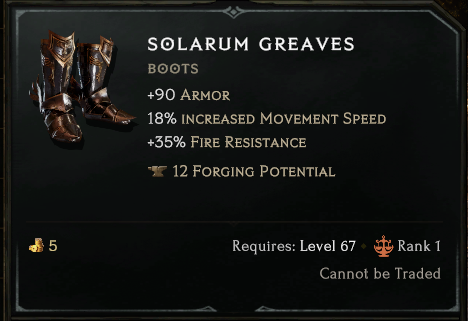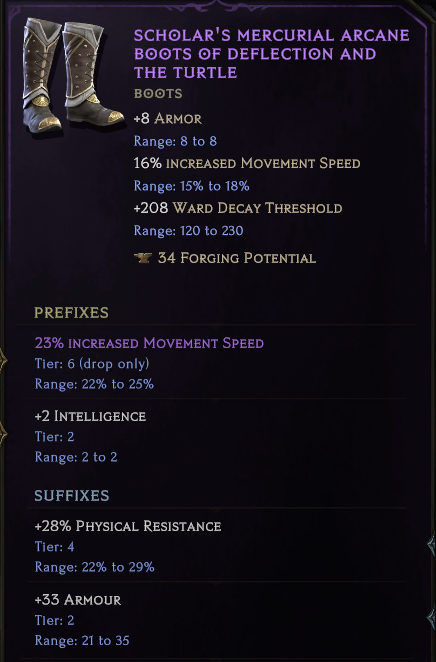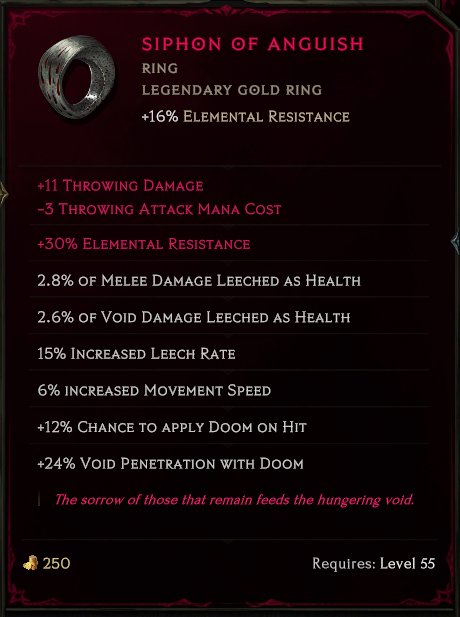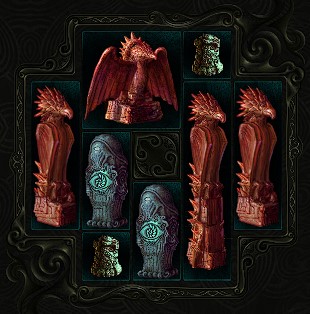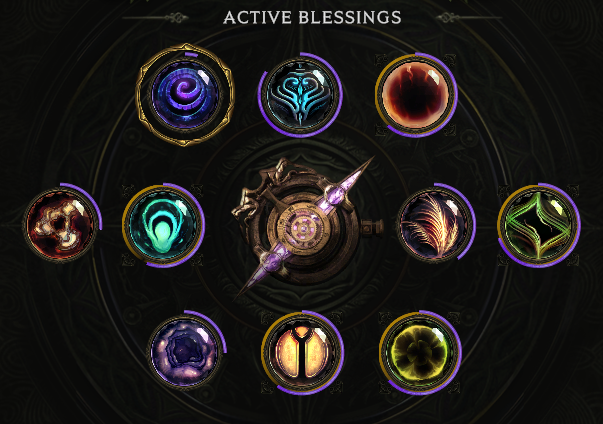Gear Walkthrough
Last Updated:July 9, 2024|Change Log
Introduction
Last Epoch is a game with a lot of gear. In fact, there are up to 41 gear slots (using 1x1 Idols) on a single character! Not having a basic understanding of how gear works makes trying to improve a character confusing and even at times frustrating, so in this article we're going to explain how it works. We cover everything from the gear slots themselves, to affixes and rarity of gear, Blessings and Idols and even smart loot!
Gear Slots
Gear slots are where we place our gear to make it an active part of our character and receive the benefits that the gear provides. As we mentioned in the introduction there's a lot of gear in Last Epoch, but it can be broken down into 3 general categories:
- Traditional gear: This is stuff like helmets, boots, jewelry, and our weapons.
- Idols: These are items that fit into their own slots and can be combined in different ways.
- Blessings: These are permanent upgrades that are obtained from bosses in the Monolith of Fate. Each boss has its own pool of Blessings and each character has a blessing slot for each boss, meaning we can choose one from each.
We cover Idols and Blessings in a later section, but for now let's break down traditional gear a bit more. There are 11 slots for traditional gear:
- Weapon
- Off-hand/Second Weapon
- Helmet
- Body Armor
- Belt
- Gloves
- Boots
- Relic
- Amulet
- 2 Ring Slots
Each slot will only accept gear that fits its description. Example: the relic slot will only accept relics like Spirit Catcher or Tome of Elements. The Off-hand is the only slot with multiple types that can fit. It will take a Shield, Catalyst, or for characters that can Dual-Wield it will take a 1 handed weapon that is appropriate for that class.
Rarity
By breaking up items into color coded categories based on the properties of the item, rarity gives us a general idea of the kind of item we're looking at. It applies primarily to traditional gear, although one exception is that Idols can be Unique. Beyond that, blessings and idols are always the same rarity. However there are a number of rarities for traditional gear:
- Common: The item has no affixes
- Magic: The item has 1-2 affixes
- Rare: The item has 3-4 affixes
- Unique: A special item that has unique stats and/or effects. If a Unique has Legendary Potential it can also be combined with an Exalted item to create a Legendary
- Set: Similar to Unique except it has bonuses when wearing multiple parts of the same set. It also cannot have Legendary Potential and therefore cannot be used to create a Legendary.
- Exalted: This is a Magic or Rare item that also has at least one Tier 6 or 7 affix.
- Legendary: An item created from combining a Unique with Legendary potential and an Exalted of the same item type or by leveling up and item with Weaver's Will. It maintains the properties of the Unique and adds 1 or more affixes from the Exalted.
- Experimental: These are items with a special affix that only drops off of Exiled Mages. They can also be any of the other craftable rarities that have at least one affix, including Exalted.
All of these rarities share two things in common. They all are connected to a base item with implicit affixes and they all (except for common) have additional affixes beyond the implicits. In the next two sections we'll explain how these work.
For more information on Legendaries check out our Legendary Items Crafting Guide.
For more information on Experimental Affixes check out our guide on Exiled Mages.
Base Items & Implicit Affixes
As far as gear goes everything except for Blessings is attached to a base item. Even Idols have base items that determine the size and class restrictions of that idol (more on this later). However this section will be devoted to traditional gear.
Each gear slot has a number of base items and each base has a different implicit. Example: Outcast Boots and Solarum Greaves are two base items for boots. We can see that Outcast Boots have implicits for armor, movement speed, and dodge rating while Solarum Greaves have higher armor and movement speed and also have fire resistance but no dodge. Some base items are also class exclusive. Example: Augury Helm can only be worn by Sentinels while Fiend Cowl is Acolyte exclusive.
The base item is the start of how an item will ultimately take shape, but it is far from the end. Once we've determined the base and its implicits we need to look at the affixes.
Explicit Affixes
Explicit affixes are what really set an item apart from the others. These are affixes that aren't tied to the base item the way implicit affixes are. The right explicit affixes can be the difference between a best in slot item and one that isn't even worth picking up.
Magic, Rare and Exalted Affixes
For magic, rare and exalted items affixes are broken up into two types: prefixes and suffixes. Prefixes are at the top of the affix list and are generally offensive, utility or class specific in nature. Suffixes are at the bottom of the list and are generally defensive in nature. These items can have up to two prefixes and two suffixes (with one exception that we'll discuss soon). Each affix has a tier attached to it that determines how powerful it is:
- Tier 1 is the least powerful and tier 7 is the most powerful.
- Only exalted items can have tier 6 and 7 while magic and rare can have up to tier 5.
- Affixes can also be crafted up to tier 5. Crafting requires Forging Potential.
- Each tier also has a roll range so even if two items have the same affix in the same tier they may not roll exactly the same.
The exalted boots here have two prefixes and suffixes, which are denoted by the arrows to the left and right side (left is prefix, right suffix). The prefixes are Tier 6 (exalted) and 2 while the suffixes are 4 and 2. Also note the roll range of each affix. When hovering over an item normally it will show less information than we're seeing here. To get this more detailed view press and hold 'alt' while hovering over the item.
Items in this category can add one more affix, called a Sealed affix. This affix can be either a prefix or suffix, and typically added either by using a Glyph of Despair, empowering a Nemesis, or finding an item that already has one in the Soulfire Bastion dungeon.
- When using a Glyph of Despair it moves an existing prefix/suffix to the sealed affix slot and opens up the other slot which allows us to craft a new affix in that slot.
- Nemesis is the only way to seal a Tier 5, 6 or 7 affix on an item. Glyph of Despair and Soulfire Bastion cap at Tier 4
One other stat you may have noticed on this type of gear is Forging Potential. While not technically an affix, this is still an important stat for affixes because it is needed in order to craft on an item. We suggest checking out our beginner crafting guide for more info, but the most important thing you need to know for now is that crafting on items uses Forging Potential and reaching 0 means the item can no longer be crafted on.
For more information on Forging Potential and Sealed affixes check out our Beginner Crafting Guide.
Unique Affixes
Affixes on Uniques don't follow the same formula as their Common, Magic, Rare, and Exalted counterparts. Each Unique has the same affixes on it (Tempest Maw will always have Melee Lightning Damage, Spell Lightning Damage, Totem Mana Cost, and Strength and Attunement), but when comparing between different Uniques:
- They don't have a consistent number of affixes.
- They don't use prefixes/suffixes and don't have tiers.
- They often do have roll ranges.
- They can't be crafted on.
There are two other 'affixes' that can be found on Unique items that are specific to them, called 'Legendary Potential' and 'Weaver's Will'. These stats determine whether a Unique can be turned into a Legendary and if so, how many affixes it will receive. We'll go into more detail later in this article when we discuss Legendaries.
Set Affixes
Affixes for sets work similarly to Uniques. The biggest difference comes from the set bonuses provided when wearing multiples of the same set. Sets can have anywhere from 1 to 3 bonuses and multiple bonuses usually require additional pieces of the set to be worn. The other difference is sets can't have Legendary Potential.
Legendary Affixes
Legendaries are a hybrid of Unique and Exalted items and their affixes reflect that. They can be made in two ways: either through Legendary Potential or Weaver's Will.
Legendary Potential
When a Legendary is made, it retains all of the affixes from the Unique (the rolls are also kept) but adds 1-4 affixes from the Exalted items. How many affixes it adds is determined by the Legendary Potential on the Unique that was used. The rules for Unique affixes apply to the portion of the Legendary that came from the Unique, and the rules for Exalted affixes apply to the Exalted portion. Note that when a Legendary is made it cannot be crafted on, but the Exalted used in the process can be crafted before making it. In order to make a Legendary players must complete The Temporal Sanctum dungeon.
For more information on Legendaries made this way check out our Legendary Items Crafting Guide.
Weaver's Will
Weaver's Will works different from Legendary Potential. It doesn't require an Exalted item to craft. Instead, items with Weaver's Will are 'leveled up' by wearing them and killing monsters. When the item levels it gains either an Affix or a Tier on an existing affix. Up to 4 new affixes can be added (two prefixes, two suffixes) and they can be upgraded as high as Tier 7. Whether a new Affix is added or a Tier is upgraded is random. Each upgrade on the item lowers the Weaver's Will by one. This process can be continued until there is no more Will left on the item.
For more information on Legendaries made this way check out our Weaver's Will Guide.
That covers all of the traditional gear, but there are still two other types of gear we need to discuss: Idols and Blessings.
Idols
Idols are a special kind of gear that share some similarities to Diablo 2's Charm system. The biggest difference is while Charms took up inventory space, Idols have their own slots that must be filled in order to activate them. There are a total of 20 slots that can be unlocked through the campaign.
Idols themselves come in different shapes and sizes that must be accounted for when deciding which idols to use. Larger sizes will limit how many total Idols can be used and some shapes are incompatible with other shapes or limit how many can be used. The sizes are 1x1 (Small Lagonian Idol and Small Eterran Idol), 1x2 (Stout Lagonian Idol), 2x1 (Humble Eterran Idol), 1x3 (i.e. Large Rahyeh Idol), 3x1 (i.e. Grand Majasan Idol), 1x4 (i.e. Huge Arcane Idol), 4x1 (i.e. Ornate Heorot Idol) and 2x2 (i.e. Adorned Immortal Idol).
Idols that are 1x1, 2x1 and 1x2 are universal and can be used by any class. All others are class specific and can only be worn by the appropriate class for that Idol. All sizes have Idols for each class, so there isn't a scenario where a size doesn't apply to a certain class.
Most Idols are the same rarity and come with one prefix, one suffix and no implicits. Unlike traditional gear, these affixes don't follow a particular theme (like how suffixes are defense focused on traditional gear). Each size of Idol has a pool of prefixes and suffixes it can draw from, with class specific ones only drawing from the pool that applies to their class. Prefixes and suffixes are not linked together, meaning any combination of prefixes and suffixes that are in the pool for that Idol size can drop.
One exception to Idol rarity is Uniques. There are currently three: Singularity, Throne of Ambition and Trinity of Flames. These don't follow typical rules for Idols, instead taking on the rules for Uniques (except they cannot have Legendary Potential).
Blessings
Blessings are a kind of 'gear' that is unique to Last Epoch and only found in the Monolith of Fate endgame system. The Monolith has a number of islands called Timelines that each have their own boss which must be killed to complete the Timeline. Upon killing the boss players are rewarded with a selection of Blessings. These Blessings range anywhere from increased power (i.e. Binds of Nature) to improved drop rates for certain items (i.e. Arrogance of Argentus). The Blessing is permanent and universal meaning it applies to every activity in the game, not just the Monolith.
Blessings only have one affix and one tier but their roll range is generally much higher than traditional gear. There are also two versions of them. The first has lower rolls and is found in normal Timelines while the second has higher rolls and is only found in Empowered Timelines which are much harder versions of the normal ones. If the Blessings a boss drops are not the right ones or the roll is low, the boss can be killed again to get a new set of Blessings. Selecting one of the new ones will override any previous Blessing so these can be farmed until the right Blessing with a sufficient roll drops.
For more information on Blessings check out our Monolith Beginner Guide.
Smart Loot
While smart loot isn't gear, it does affect how gear drops. Smart loot applies to any gear slot that has class specific Common, Magic, Rare and Exalted items (helmets, body armor, relics, Idols and weapons). When an item drops for one of these slots, the game heavily biases the drop towards being an item that is wearable for the class you're playing on. Example: If you're playing a Primalist and body armor drops, it is far more likely that it will be Primalist specific body armor than Acolyte or some other class that isn't Primalist. This makes it much easier to gear a character since these slots that have a lot of items which aren't relevant to your class would otherwise only have a 1 in 5 chance of dropping something potentially useful. Smart loot does not apply to Uniques and Set items so you don't need to worry about farming those on the same class!
Summary
- Last Epoch has 11 traditional gear slots plus Idols and Blessings
- Traditional Gear always has a Base Item with Implicit Affixes
- Magic, Rare, and Exalted items can also have Explicit Affixes which can be crafted and max out at 5 (with one being Sealed).
- Each Explicit Affix also has up to 7 tiers which determine the roll range for that Affix.
- Unique items also have Explicit Affixes but cannot be crafted, are not limited to 5 and do not have tiers.
- Legendaries are made by combining a Unique with Legendary Potential and an Exalted of the same item type.
- Idols are a special type of gear that share some similarities to Charms in Diablo 2.
- Blessings are a unique kind of gear that are obtained by killing Timeline bosses in the Monolith of Fate.
- Smart loot makes it easier to get gear for slots that have class specific bases.
Video
Credits
Written by McFluffin.
Reviewed by Aristotelian, Terek.




